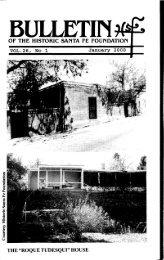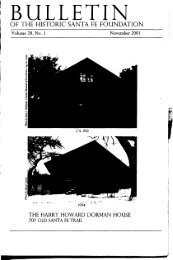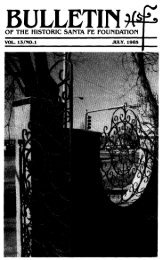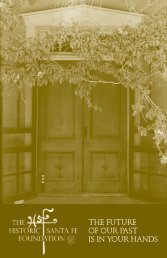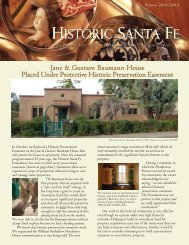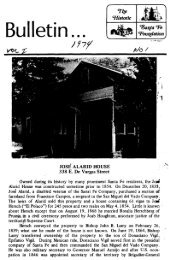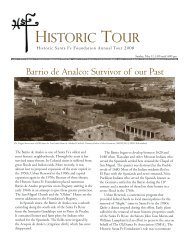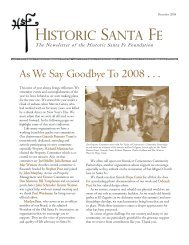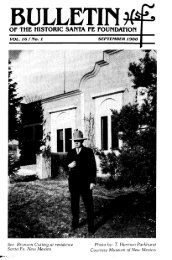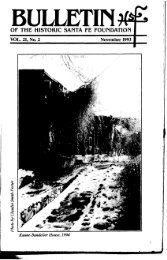Witter Bynner House - Historic Santa Fe Foundation
Witter Bynner House - Historic Santa Fe Foundation
Witter Bynner House - Historic Santa Fe Foundation
Create successful ePaper yourself
Turn your PDF publications into a flip-book with our unique Google optimized e-Paper software.
Mabel Dodge Luhan of Taos to<br />
spend their first night in New<br />
Mexico under <strong>Bynner</strong>'s roofamong<br />
the first of numerous<br />
artists who would enjoy the<br />
hospitality of <strong>Bynner</strong>'s horne.<br />
That spring he traveled with<br />
the Lawrences to Mexico and<br />
first visited Chapala, where he<br />
would spend a part of nearly<br />
every year. In 1940he bought a<br />
horne there, which he renovated<br />
and greatly enlarged.<br />
<strong>Bynner</strong> was the source of a<br />
minor character in Lawrence's<br />
The Plumed Serpent and in 1951<br />
published a prose account of<br />
the trip entitled, "Journey With<br />
Genius." His relationship with<br />
Mabel Dodge Luhan soon deteriorated<br />
into a malicious rivalry<br />
and he satirized her in a 1926<br />
verse play, Cake:An Indulgence.<br />
In <strong>Santa</strong> <strong>Fe</strong> <strong>Bynner</strong> found a<br />
stimulating intellectual atmosphere<br />
combined with a refreshingly<br />
"simple" life and an easygoing<br />
acceptance of the unconventional.<br />
He became a leader<br />
of the literary colony and his<br />
horne was the center of a prodigious<br />
social life. He cut an<br />
unusual figure, even among<br />
<strong>Santa</strong> <strong>Fe</strong>'s unconventional<br />
artists, often dressing in<br />
Chinese robes or Navajo shirt<br />
and concha belt. His schedule<br />
was also his own. He habitually<br />
worked at his desk until<br />
dawn and then perhaps gardened<br />
before going to bed. He<br />
breakfasted at about one<br />
o'clock and then worked until<br />
the late afternoon when he was<br />
S<br />
ready to receive guests. A sign<br />
on his door made by John Sloan<br />
announced that no one should<br />
call before five in the evening.<br />
One could, however, remain<br />
until any hour after which<br />
<strong>Bynner</strong> would write until daylight.<br />
His parties were legend<br />
and he was particularly remembered<br />
for- entertaining at the<br />
piano with songs sometimes<br />
composed on the spot and often<br />
bawdy. It was said that everybody<br />
who was anybody visited<br />
his horne when in <strong>Santa</strong> <strong>Fe</strong>.<br />
<strong>Bynner</strong> was deeply interested<br />
in politics and said that to<br />
him "poetry and politics were<br />
the two most important things<br />
in the world."s Throughout his<br />
life he championed the rights of<br />
women and minorities. While<br />
at Harvard and in succeeding<br />
decades, he actively campaigned<br />
for women's suffrage.<br />
A 1911 photograph shows him<br />
and John Dewey leading the<br />
men's contingent of a suffrage<br />
parade down Fifth Avenue. In<br />
New Mexico he continued his<br />
interest in politics and was a<br />
dedicated advocate for the<br />
rights of American Indians. He<br />
strongly supported Senator<br />
Robert LaFollette's 1924<br />
Progressive Party candidacy for<br />
president and in 1926 ran<br />
unsuccessfully as a Democratic<br />
candidate for the State<br />
Legislature.6 In 1937 while in<br />
Mexico he met with Trotsky,<br />
the exiled Russian revolutionary,<br />
whom he had met years<br />
before in Greenwich Village.



